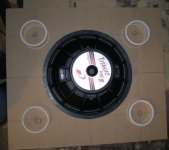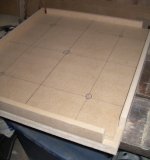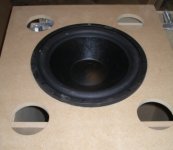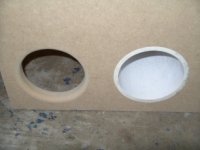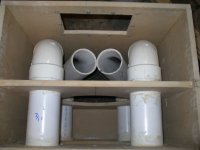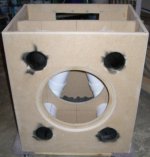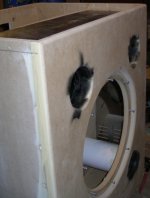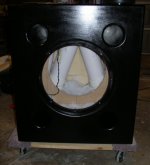Dual 15" Dayton Titanic MKIII Design Help
Ok, so I found this forum a while back, and decided to build my next sub. I ordered a 12" Titanic MKIII with the 500W Bash Digital amp. I choose the Bash because heat is always a problem between my fish tanks, 5 computers and Stereo. I put it in a simple sealed enclosure and love it. I max out the 12 occasionally and have to turn the Bash amp down to about 50%.
I had planned on adding another 12, but after seeing the displacement volume of the 15", I went ahead and ordered 2 of the 15" MKIII's. They arrive sometime next week. I would like to build a well designed box for them, and I have some questions.
First off the layout, the room is about 20x20 with 6 separate doors and hallways that go to other parts of the house. So it's very open, and it has 12' Vaulted ceilings. The floor is currently carpet but will go to hardwoods in a year or two. Don't think I get too much room gain. I want the subs hidden so corners of the room are not an option, plus there's only 1 that's not a walkway.
I'm also building a projector and my plan is to build a side board about 30" tall with 3 cabinet doors to sit under the 100" projection screen. The doors will have cloth centers (I'm going to make them). I plan on housing the subs on each side, with the computer and center channel speaker in the center compartment. The rest of the speakers are all in the ceiling, So it will look like a normal living room that doesn't even have a TV! (hehe) The receiver is racked up in the computer closet in the adjacent Study with the rest of the whole house audio system. I listend to an equal mix of music and movies.
So I put the parms into win ISD, and it gave me an optimal sealed box dimension of about 19"Wx12"Dx30"H. I could make it deeper
by going up to 18-20" to cut down on the height.
The current 12" MKIII is in an 18x18x22 cabinet + spikes which is what I was planning to build the sideboard cabinet around. So looking at a ported design in winiSD gives me 24"Wx37 1/2"Hxx15"D 180 Liters. That's too high! I need to keep it under 30"H to fit in the sideboard, and have the sideboard fit under the screen. The largest I could probably build is 24"Wx28"Hx20"D which is also 180 Liters.
So my questions:
* With a room this size would 2 ported 15" overpower it? I'm running each with a 500W Bash. Should I just go with a simple sealed enclosure?
* Most of the ported boxes I've reviews are really deep, how does changing the shape affect performance?
* On the ports, does 2 smaller instead of 1 larger affect performance? Does it matter if I put them above the sub? (I don't want them blocked by the cabinet base they are going to sit in.
* Do you guys build a sealed compartment for the plate amp? If so, why?
*The bash amp has to sit at about 50% volume so the sub doesn't max out. Is this normal, or a result of running everything from the computer and having 3 different volumes?
If there are good threads/pages to read that would help, they would be much appreciated as well. I'm lost on tuning frequency, a good link would be appreciated.
Ok, so I found this forum a while back, and decided to build my next sub. I ordered a 12" Titanic MKIII with the 500W Bash Digital amp. I choose the Bash because heat is always a problem between my fish tanks, 5 computers and Stereo. I put it in a simple sealed enclosure and love it. I max out the 12 occasionally and have to turn the Bash amp down to about 50%.
I had planned on adding another 12, but after seeing the displacement volume of the 15", I went ahead and ordered 2 of the 15" MKIII's. They arrive sometime next week. I would like to build a well designed box for them, and I have some questions.
First off the layout, the room is about 20x20 with 6 separate doors and hallways that go to other parts of the house. So it's very open, and it has 12' Vaulted ceilings. The floor is currently carpet but will go to hardwoods in a year or two. Don't think I get too much room gain. I want the subs hidden so corners of the room are not an option, plus there's only 1 that's not a walkway.
I'm also building a projector and my plan is to build a side board about 30" tall with 3 cabinet doors to sit under the 100" projection screen. The doors will have cloth centers (I'm going to make them). I plan on housing the subs on each side, with the computer and center channel speaker in the center compartment. The rest of the speakers are all in the ceiling, So it will look like a normal living room that doesn't even have a TV! (hehe) The receiver is racked up in the computer closet in the adjacent Study with the rest of the whole house audio system. I listend to an equal mix of music and movies.
So I put the parms into win ISD, and it gave me an optimal sealed box dimension of about 19"Wx12"Dx30"H. I could make it deeper
by going up to 18-20" to cut down on the height.
The current 12" MKIII is in an 18x18x22 cabinet + spikes which is what I was planning to build the sideboard cabinet around. So looking at a ported design in winiSD gives me 24"Wx37 1/2"Hxx15"D 180 Liters. That's too high! I need to keep it under 30"H to fit in the sideboard, and have the sideboard fit under the screen. The largest I could probably build is 24"Wx28"Hx20"D which is also 180 Liters.
So my questions:
* With a room this size would 2 ported 15" overpower it? I'm running each with a 500W Bash. Should I just go with a simple sealed enclosure?
* Most of the ported boxes I've reviews are really deep, how does changing the shape affect performance?
* On the ports, does 2 smaller instead of 1 larger affect performance? Does it matter if I put them above the sub? (I don't want them blocked by the cabinet base they are going to sit in.
* Do you guys build a sealed compartment for the plate amp? If so, why?
*The bash amp has to sit at about 50% volume so the sub doesn't max out. Is this normal, or a result of running everything from the computer and having 3 different volumes?
If there are good threads/pages to read that would help, they would be much appreciated as well. I'm lost on tuning frequency, a good link would be appreciated.
You can't overpower a room hehe! You'll just adjust the gains on the amplifiers to have a balanced system. You can go sealed if you want to.
Ported boxes can be of any shape, it's not important.
You can put the ports anywhere if you plan on tuning low. You could use passive radiators too.
Yes you can use 2 smaller ports, but why do you want to do that? It will be the same length as one bigger anyway.
If the amplifier is perfectly 100% sealed, doesn't leak any air on the outside, there's no need to have a sealed chamber for the amplifier.
On the Bash amplifier, you're playing with the gain, this is to adjust the volume of your subwoofers with the rest of the system. Yes it's normal that loud passages will overload the subwoofer if the gain is too high. It's probably overloading the amplifier too.
Good website to start learning a bit :
http://www.diysubwoofers.org/
Tuning frequency is the lowest frequency your subwoofer will produce or so without problems. It's the frequency where you tune the box to have a higher gain at that frequency and near it.
Ported boxes can be of any shape, it's not important.
You can put the ports anywhere if you plan on tuning low. You could use passive radiators too.
Yes you can use 2 smaller ports, but why do you want to do that? It will be the same length as one bigger anyway.
If the amplifier is perfectly 100% sealed, doesn't leak any air on the outside, there's no need to have a sealed chamber for the amplifier.
On the Bash amplifier, you're playing with the gain, this is to adjust the volume of your subwoofers with the rest of the system. Yes it's normal that loud passages will overload the subwoofer if the gain is too high. It's probably overloading the amplifier too.
Good website to start learning a bit :
http://www.diysubwoofers.org/
Tuning frequency is the lowest frequency your subwoofer will produce or so without problems. It's the frequency where you tune the box to have a higher gain at that frequency and near it.
Thanks Simon, that helps. I think I'm going to build a simple sealed enclosure. IF I understand it correctly
A couple of other things:
From what I've read, I can't make the box too big, it will simply help it perform better at lower frequencies. I also shouldn't need any stuffing, because of the box size and it won't have an effect on the low frequencies anyway. Is that accurate?
Does anyone have a complete .wdr file for the 15" MKIII? I followed the help files on how to populate it and I get a division by zero. When I tried filling everything out If just tells me there's a problem in one of the 30+ parms. Really time consuming and frustrating.
Also, how do I tell the tuning frequency from winISD?
Subs are arriving Thursday, this is going to be fun. . .
A couple of other things:
From what I've read, I can't make the box too big, it will simply help it perform better at lower frequencies. I also shouldn't need any stuffing, because of the box size and it won't have an effect on the low frequencies anyway. Is that accurate?
Does anyone have a complete .wdr file for the 15" MKIII? I followed the help files on how to populate it and I get a division by zero. When I tried filling everything out If just tells me there's a problem in one of the 30+ parms. Really time consuming and frustrating.
Also, how do I tell the tuning frequency from winISD?
Subs are arriving Thursday, this is going to be fun. . .
That would be great
My E-mail is chance <underscore> 11@yahoo.com
Thanks for replying. I've been follwing your post by the way.
My E-mail is chance <underscore> 11@yahoo.com
Thanks for replying. I've been follwing your post by the way.
If you go sealed, you can use stuffing if you want to, it will be bigger acoustically for the driver. Can help you design a smaller box than usual. As you said, it's not necessary on the other hand.
You are using WinISD Pro alpha? You followed the help files and it didn't work? You sure?
I'll simplify the procedure...
Enter Fs.
Click in another box to change the focus.
Enter Re.
Click in another box to change the focus.
Enter Sd.
Click in another box to change the focus.
Enter Le.
Click in another box to change the focus.
Enter Xmax.
Click in another box to change the focus.
Enter Pe.
Click in another box to change the focus.
Enter Vas.
Click in another box to change the focus.
Enter Qts.
Click in another box to change the focus.
Enter Qes or Qms.
Click in another box to change the focus.
Every useful box should be filled by now.
Don't change the other parameters.
Save.
Done.
You can see the tuning frequency in the box tab in the small windows that was opened with your project.
You are using WinISD Pro alpha? You followed the help files and it didn't work? You sure?
I'll simplify the procedure...
Enter Fs.
Click in another box to change the focus.
Enter Re.
Click in another box to change the focus.
Enter Sd.
Click in another box to change the focus.
Enter Le.
Click in another box to change the focus.
Enter Xmax.
Click in another box to change the focus.
Enter Pe.
Click in another box to change the focus.
Enter Vas.
Click in another box to change the focus.
Enter Qts.
Click in another box to change the focus.
Enter Qes or Qms.
Click in another box to change the focus.
Every useful box should be filled by now.
Don't change the other parameters.
Save.
Done.
You can see the tuning frequency in the box tab in the small windows that was opened with your project.
That did the trick. Not sure what I did wrong before. Now It's all starting to make sense. After looking at the output of a sealed vs ported I'm pretty sure I want to go ported. The box
The one thing that bothers me is the group delay at 20Hz is 30ms. Is that value too high?
So the box dimensions I've decided on, that I think I can still fit into the cabinet I'm going to build are:
26"L x 20"D x 29.5"H
The Internal dimensions are going to be:
24.5"D x 17"D x 24.5"H
That should give me right around 181L.
Since I'm using 3/4 MDF, 1 divider in the middle of the box, and 2- 3/4 boards on the front so I can flush mount the sub, and be able to flare the ports with a router.
To keep air velocity under 20 m/s I need 3- 4" ports that are 10", which would have to be doubled to 6 for the other sub.
No way am I going to spend $13x6 = $80 on port tubes when I can make them look just as nice with PVC.
One question, when adding multiple tubes the lengh in winISD is multiplied by the number of ports, so I divide that to get the length per port right?
As I was typing this, one of the speakers showed up a day early. It's big alright. If you guys see any problems or have any suggestions for me, please let me know. Thanks for the help so far. . .
It's big alright. If you guys see any problems or have any suggestions for me, please let me know. Thanks for the help so far. . .
The one thing that bothers me is the group delay at 20Hz is 30ms. Is that value too high?
So the box dimensions I've decided on, that I think I can still fit into the cabinet I'm going to build are:
26"L x 20"D x 29.5"H
The Internal dimensions are going to be:
24.5"D x 17"D x 24.5"H
That should give me right around 181L.
Since I'm using 3/4 MDF, 1 divider in the middle of the box, and 2- 3/4 boards on the front so I can flush mount the sub, and be able to flare the ports with a router.
To keep air velocity under 20 m/s I need 3- 4" ports that are 10", which would have to be doubled to 6 for the other sub.
No way am I going to spend $13x6 = $80 on port tubes when I can make them look just as nice with PVC.
One question, when adding multiple tubes the lengh in winISD is multiplied by the number of ports, so I divide that to get the length per port right?
As I was typing this, one of the speakers showed up a day early.
chance_11 said:The one thing that bothers me is the group delay at 20Hz is 30ms. Is that value too high?
To keep air velocity under 20 m/s I need 3- 4" ports that are 10", which would have to be doubled to 6 for the other sub.
One question, when adding multiple tubes the lengh in winISD is multiplied by the number of ports, so I divide that to get the length per port right?
30 ms at 20 Hz isn't that bad.
You don't divide by the number of ports. WinISD reports the correct length for each port. One 4" port will tune to a certain frequency. Two ports will need to be ~twice as long to tune at the same frequency because the air mass spring is less strong.
You could use two full length precision port 4" to get a 23 Hz tuning in your 181 liters box. That would be a nice compromise.
 Thanks Simon. Luckily I can still fix it. I see by adjusting the lenth of the port in winISD how it moves the tuning frequency.
Thanks Simon. Luckily I can still fix it. I see by adjusting the lenth of the port in winISD how it moves the tuning frequency.I thought I would post my measurments in case somebody wanted to try and build this. Here they are for 1 sub:
Front/Back: 26"x29.5"
Internal: 24.5"x28"
Top/Bottom: 19"x24.5"
Sides: 29.5"x19"
You need 2 of each of the above. I made 4 of each for my 2 boxes and did it with 4 sheets of 3/4 MDF.
I test fit one of the boxes with corner clamps to ensure everything was ok, and then started to layout the speaker and ports. I decided to put the speaker in the center and ports in the 4 corners.
Attachments
Then I stacked 3 board together and lined them up with some scraps. That way I could drill the holes for the circle jig, and they should line up perfectly when I assymble the box. I think this is better than trying to measure each board because they will vary slightly. Anyway, I used a centerpunch to start the drill bit correctly, and I used an attachment on my drill that almost creates a mini drill press, so I'm sure to get 90 degree angles on all the holes.
I drilled 3 at a time (drill bit depth limitation) and then used the top one to redrill other boards for the second box.
I drilled 3 at a time (drill bit depth limitation) and then used the top one to redrill other boards for the second box.
Attachments
Ports
Now, on the ports I have a couple of questions.:
1. Where do I measure a flared port? from the middle of the flare or the very end?
2. Do 90 degree turns in the port tube change anything? It should add some resistance to the flow, with is similar to what extending the length would do.
3. Should they all be exactly the same length? If I can make 2 of them longer than the other two, should I do it?
Here's how I'm making my flares. The hole on the right is what the front will look like. It's cut to exactly match the inner diameter of the 4" pipe. The other one actually has the pipe in it. So my plan is to do the front plate like the hole on the left, then the 3/4 right behind that will be on the right, and the brace in the center of the box will also hold the pipe in place.
Now, on the ports I have a couple of questions.:
1. Where do I measure a flared port? from the middle of the flare or the very end?
2. Do 90 degree turns in the port tube change anything? It should add some resistance to the flow, with is similar to what extending the length would do.
3. Should they all be exactly the same length? If I can make 2 of them longer than the other two, should I do it?
Here's how I'm making my flares. The hole on the right is what the front will look like. It's cut to exactly match the inner diameter of the 4" pipe. The other one actually has the pipe in it. So my plan is to do the front plate like the hole on the left, then the 3/4 right behind that will be on the right, and the brace in the center of the box will also hold the pipe in place.
Attachments
Hey chance... Sorry for the delay. I completely forgot what thread you were in. OOPS! 
Anyway, it looks like you got everything going fine with WinISD without my help.
What freq are you tuning to anyway? I'm just curious because xstephanx over in my thread mentioned tuning real low like 11-12Hz to drastically lower the excursion of the drivers, which in turn drastically lowers the distorsion.
Since I just repositioned my center channel, I now have probably close to an extra foot of room to expand the enclosure into, giving me plenty of room for a larger enclosure. And for the low tuning (I'm going with 12Hz) my port length is going to be about 60" long. The mouth of the port is going to be 2.5" x 13", which will have an extremely low port air velocity (a.k.a. - no port noise). Group delay will also be very low, 11m/s @ 20Hz.
I just thought I would share that with you since both of our projects are kind of similar.
Anyway, good luck with your project!

Anyway, it looks like you got everything going fine with WinISD without my help.
What freq are you tuning to anyway? I'm just curious because xstephanx over in my thread mentioned tuning real low like 11-12Hz to drastically lower the excursion of the drivers, which in turn drastically lowers the distorsion.
Since I just repositioned my center channel, I now have probably close to an extra foot of room to expand the enclosure into, giving me plenty of room for a larger enclosure. And for the low tuning (I'm going with 12Hz) my port length is going to be about 60" long. The mouth of the port is going to be 2.5" x 13", which will have an extremely low port air velocity (a.k.a. - no port noise). Group delay will also be very low, 11m/s @ 20Hz.
I just thought I would share that with you since both of our projects are kind of similar.
Anyway, good luck with your project!
NP Chops. Yea, it's comming along. I'm tied up this weekend, progress will have to wait till next week unfortunately.
As for the tuning frequency, I don't know yet. The number one design goal is to build speakers that can dissapear into the furniture. That way I don't have big speakers showing, and my hottie girlfriend sill comes to see me.
I got the port length wrong, so I get to correct that now, but I couldn't have changed the box dimensions anyway. They are as large as I could make them.
With right turns the ports should be in the 30-40" range, which should give me a velocity of 16m/s (with 4), crosses -3db at 21Hz, and 0db at 27Hz on the transfer function graph. How exactly do I read tuning frequency from the graphs? Is it the -3db point?
Cone excersion doesn't cross x-max until about 18hz, and I plan on using some kind of high pass filter.
Also, where it goes over 0db, does that mean It will get an extra boost in that range?
As for the tuning frequency, I don't know yet. The number one design goal is to build speakers that can dissapear into the furniture. That way I don't have big speakers showing, and my hottie girlfriend sill comes to see me.
I got the port length wrong, so I get to correct that now, but I couldn't have changed the box dimensions anyway. They are as large as I could make them.
With right turns the ports should be in the 30-40" range, which should give me a velocity of 16m/s (with 4), crosses -3db at 21Hz, and 0db at 27Hz on the transfer function graph. How exactly do I read tuning frequency from the graphs? Is it the -3db point?
Cone excersion doesn't cross x-max until about 18hz, and I plan on using some kind of high pass filter.
Also, where it goes over 0db, does that mean It will get an extra boost in that range?
Box tuning is in the box tab, under box size.
Yeah you get extra boost over the 0 dB point, could be caused by inductance. If the boost isn't too high, no problems with that.
Port with flared ends, yeah you could measure from the middle of the flare I guess. Precision ports for example are 18" long but only 17" acoustical length.
Do them all the same length. Different length will change the tuning.
Yeah you get extra boost over the 0 dB point, could be caused by inductance. If the boost isn't too high, no problems with that.
Port with flared ends, yeah you could measure from the middle of the flare I guess. Precision ports for example are 18" long but only 17" acoustical length.
Do them all the same length. Different length will change the tuning.
I woked on the box yesterday, and got it assymbled. I started with the 2 front poards and used the short pieces of pipe for the ports to line everything up. Then I used my finish nailer to hold them together so I could attach the sides and bottom.
Then I put the middle piece in and added the pipes. I decided on about 8" of space in the first compartment. I plan on putting some kind of steel in the box to help with magnetic shielding. I'm going to have 2 of these sitting on either side of a computer, so It's a concern. I haven't put the top on so I can slide the plates into place.
Box tuning came out to 25 Hz, as I was only able to get about 30 inches of pipe to fit. I may be getting port noise because of the close proximity of the ports to the walls. It sounds like a bird flapping it's wings, and only starts at low (<30Hz) frequencies. I'm thinking some stuffing or sound absorbing material might help.
Then I put the middle piece in and added the pipes. I decided on about 8" of space in the first compartment. I plan on putting some kind of steel in the box to help with magnetic shielding. I'm going to have 2 of these sitting on either side of a computer, so It's a concern. I haven't put the top on so I can slide the plates into place.
Box tuning came out to 25 Hz, as I was only able to get about 30 inches of pipe to fit. I may be getting port noise because of the close proximity of the ports to the walls. It sounds like a bird flapping it's wings, and only starts at low (<30Hz) frequencies. I'm thinking some stuffing or sound absorbing material might help.
Attachments
I tested it out yesterday by putting the top on, and then adding about 100lbs of weights on top. This thing rocks! It was loud from the mailbox. I found 2 lightfixtures that needed tightening. It rattles the couch like it has a bass shaker on it.
That's just with one! So adding the second should give me a higher SPL with a lower volume right?
Anyway, I'm searching for metal, sanding the wood filler, and getting ready for semi-gloss Black paint.
That's just with one! So adding the second should give me a higher SPL with a lower volume right?
Anyway, I'm searching for metal, sanding the wood filler, and getting ready for semi-gloss Black paint.
Attachments
It's Finished!
Well, I got the box done today. I could have spent more time with wood filler on the edges. However, It's going to be sitting in a cabinet behind speaker cloth, so it's not that important.
I needed to add shielding to the box, because it interfears with my old school TV, and I'm concerned when I do the projector and have a computer sitting next to it. I checked sheet metal prices, and it would have easily added another 80 bucks to the project.
So I wene to the city's transfer station, and found an old stainless steel grill or something. Anyway, I took it apart and cut the shapes I needed. It worked perfectly and it was free. The picture shows the strip on the top, and one on the side. I later put a screw into the side with 2 wires running back to the amp where I grounded on the backplate.
Well, I got the box done today. I could have spent more time with wood filler on the edges. However, It's going to be sitting in a cabinet behind speaker cloth, so it's not that important.
I needed to add shielding to the box, because it interfears with my old school TV, and I'm concerned when I do the projector and have a computer sitting next to it. I checked sheet metal prices, and it would have easily added another 80 bucks to the project.
So I wene to the city's transfer station, and found an old stainless steel grill or something. Anyway, I took it apart and cut the shapes I needed. It worked perfectly and it was free. The picture shows the strip on the top, and one on the side. I later put a screw into the side with 2 wires running back to the amp where I grounded on the backplate.
Attachments
I went to wallmart and got foam and polyfill. The picture shows How much I used. Any thoughts on more or less you guys have would be welcome. The wire running back is to ground the metal shielding. I used a hot glue gun to glue it to anything it was close to, and might therefore cause a rattle.
Attachments
- Status
- This old topic is closed. If you want to reopen this topic, contact a moderator using the "Report Post" button.
- Home
- Loudspeakers
- Subwoofers
- Dual 15" Dayton Titanic MKIII Design Help
